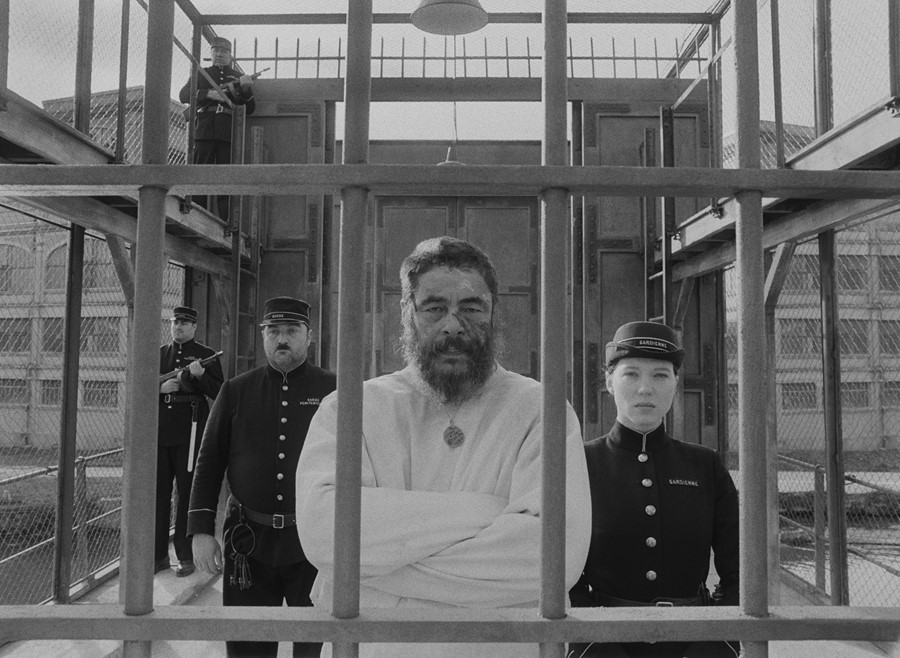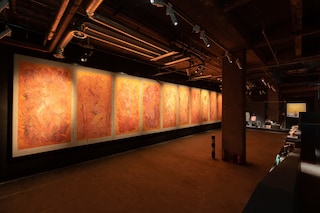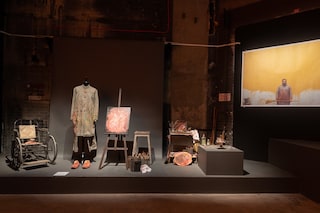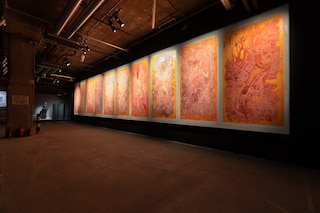The artist was commissioned to create the masterpieces by the film’s criminally insane prodigy Moses Rosenthaler – here, he discusses making the art that acts as the drama’s significant plot point
Wes Anderson’s latest film, The French Dispatch, is an intricate structure of stories within stories; a series of narrative antechambers and corridors all converging on the defining event of Arthur Howitzer Jr’s death. As The French Dispatch staff gather at their office to write an obituary for the magazine’s recently deceased editor (played with typical laconic aplomb by Wes Anderson regular Bill Murray), the narrative diverges as we follow stories that each explore the high life – and low life – of Ennuie-sur-Blazé, the fictitious French town where the movie is based.
Of all the tales from which The French Dispatch is comprised, perhaps the story with most depth is that of “The Concrete Masterpiece” – a semi-unrequited love story between a criminally insane artistic genius (played with much intensity by Benicio del Toro) and his prison guard muse. “Wes mentioned a French movie called Boudu Saved from Drowning (directed by Jean Renoir) – a 1930s movie with one of the great actors of all time, Michel Simon, as a hobo,” revealed del Toro in a recent statement. “I had seen it a long time ago and it’s a great movie, and watching it again gave me an idea of what he had in mind for the character.”
While serving a lengthy jail sentence for triple homicide, Moses Rosenthaler despairingly takes up arts and crafts as an alternative to his other main pastime of recreationally drinking mouthwash. Sandro Kopp is the real-life artist behind the portraits Rosenthaler creates of his beloved but inscrutable jailor, Simone (played by Léa Seydoux). The German-New Zealand visual artist was approached by Anderson with the ambitious commission of creating paintings that prove pivotal in the stories of all who encounter them, instigating a move from figurative painting to abstraction. The film’s art director Kevin Timon Hill told Dazed: “The storyline with the paintings is that they’re something that is going to change the world of painting, so it had to be something energetic and vibrant painted into the wall with texture. It had a to feel like a step-change in painting.”
Kopp has moved fluidly between figuration and abstraction within his own work. His trademark series of Skype portraits – incorporating the glitches of insufficient broadband and casting his subjects in the eerie blue glow of the screen – became increasingly distorted until they reached a point of total abstraction. Interestingly, his partner Tilda Swinton, who features as a recurring and beguiling subject in his work, also plays a role in the film as art critic J.K.L. Berensen – a crucial character in the story of “The Concrete Masterpiece”.
Along with his gifted assistants Sian Smith and Edith Baudrand, Kopp relocated his studio to the abandoned paper mills in the French town of Angoulême to work on the paintings amid the frenetic atmosphere of the film shoot. Here, with the input of Anderson, he created Rosenthaler’s entire oeuvre, drawing on influences such as Frank Auerbach, Willem de Kooning, and Francis Bacon while retaining a distinct style capable of acting as the catalyst for a radical rethinking of painting itself.
The artworks which feature in the film are currently on display at 180 The Strand in an exhibition devoted to the world of The French Dispatch, and Kopp’s unseen Rosenthaler works are scheduled to go on display in the future at Berlin’s Ebensperger gallery. Take a look in the gallery above for a glimpse of the current exhibition along with some key moments from the movie. Below, we talk to Sandro Kopp about working with Wes Anderson, life on the set of The French Dispatch, and the process of creating Rosenthaler’s celebrated abstractions.
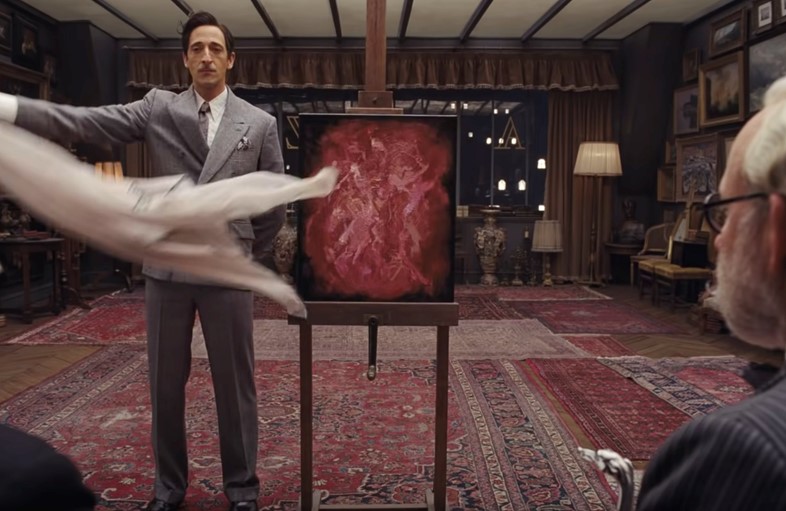
For anyone who may not have yet seen The French Dispatch, please could you explain how the paintings feature in the film and what role they play?
Sandro Kopp: They are the catalyst for the story ‘The Concrete Masterpiece’. While imprisoned for double homicide, Moses Rosenthaler develops a new abstract way of painting, inspired by his muse and guardian, Simone. His art becomes a global sensation thanks to his gallerist, Julien Cadazio (played by Adrien Brody), who has to smuggle the art world elite into the prison to see the new Rosenthaler paintings.
Could you tell us about the brief you were given by Wes Anderson? Had he already conceived some idea of what Rosenthaler’s artworks should look like?
Sandro Kopp: If I remember correctly, his first brief was ‘paintings, thickly encrusted, oily impasto; almost totally abstract; flesh from the tube… Maybe a very abstract dark kind of ‘field’ around the flesh-coloured main thing.’
I had all kinds of ideas for composition and layout initially, but those were pretty much all abandoned when I got to Angoulême and started painting. It was very much finding by doing in constant conversation with Wes.
How did you begin the process of interpreting the commission? How did the project develop?
Sandro Kopp: We started out testing various ways of rendering flesh for the first few weeks. Wes and I sent several dozen emails back and forth every day and his direction was quite general much of the time and extremely precise at others. For example, I remember he once sent back a tiny cropped-out section of a photo of a drawing I had sent him and asked me to make two tiny marks that crossed each other into one larger curved mark. But at other times he would just say something like, ‘Great! Press on! Maybe more small short brushstrokes? Less gloopy parts?’
Once the tests had led to the development of a method that created the desired look, I started actually working on the large paintings. From that point, Wes was relatively hands-off. He left much of the final decisions – such as the sequence of the paintings – up to me.
“Wes and I sent several dozen emails back and forth every day and his direction was quite general much of the time and extremely precise at others” – Sandro Kopp
Could you tell us how you envisioned the development of Rosenthaler’s painting in the film, as he moves from figuration to abstraction? In what ways does this progression reflect the arc of his story?
Sandro Kopp: The figurative moments are only briefly seen in flashbacks, so there was no need to show the development from one to the other in stages. But Wes knew that I had painted both figuratively and abstractly in the past and that I was going to be comfortable straddling both of those positions.
Were there any particular artists or other cultural references whose work most informed ‘The Concrete Masterpiece’?
Sandro Kopp: The great art historian and lecturer Rosamund Bernier – whom Tilda’s character is based on – is certainly the greatest inspiration for the story.
As far as the paintings go, we looked at countless references. Frank Auerbach, Willem de Kooning, and Francis Bacon were particularly prominent in our research, but we were very clear that we needed the paintings to be idiosyncratic and we didn’t want the art to look too much like the work of any living or dead painter.
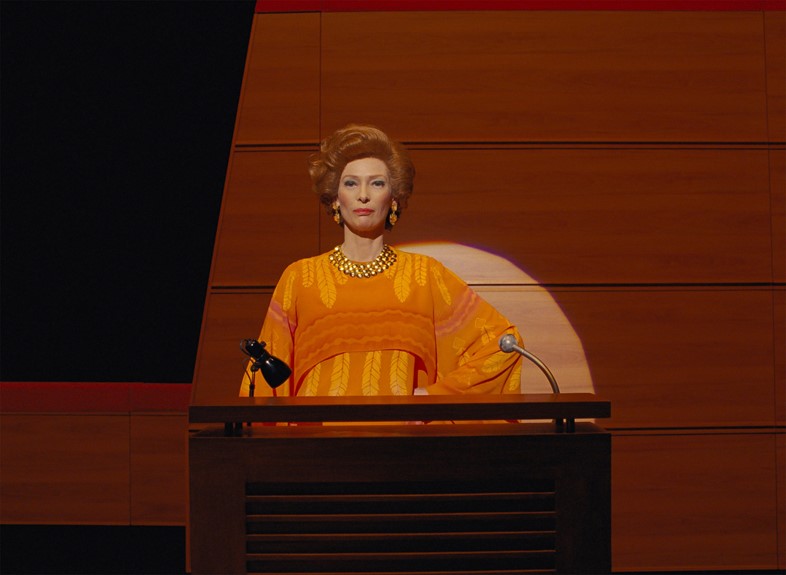
Did you relocate to Angoulême during the shoot? How did working on the set affect your practice?
Sandro Kopp: I did. I lived in Angoulême for several months. On the one hand, I loved having a huge space to work in. On the other, it was bitterly cold most of the time and sets were being constructed all around, so the noise was eye-watering. I had noise-cancelling headphones on almost constantly playing the band Screaming Females.
What are your abiding memories of that time during the making of The French Dispatch?
Sandro Kopp: Coming into the hotel Saint Gelais at the end of another freezing cold day in the studio. I had to pass through the editing suite on the way to my room and, usually, Andy (editor Andrew Weisblum) and Wes would be sitting in the dark watching some incredible scenes that they had just come back from shooting and I would linger for a few minutes and marvel.
Then peeling myself out of my paint-encrusted clothes, changing into something more appropriate and sitting with a glass of wine while the cast and crew that had shot that day gathered for dinner around the big table. I remember that mix of utter exhaustion, warming-up, and happy recounting of the day’s adventures. Blissful.
“I was so lucky that the paintings Wes asked me to make for the film were exactly the paintings I needed to make for myself at that time” – Sandro Kopp
Did the project feel like something separate from your own practice as an artist, as if you were acting as a conduit for Rosenthaler? Or do you see it as an extension and development of your own work?
Sandro Kopp: I was so lucky that the paintings Wes asked me to make for the film were exactly the paintings I needed to make for myself at that time. Having painted a very tight, small series of eye portraits for the proceeding years, these big juicy expanses of texture and colour would have been a natural progression anyway. I have continued to paint with the methods that we developed for the movie in the two years since we finished filming.
I worked in collaboration with Wes and as a filter and conduit for his ideas. Rosenthaler as a separate entity or character did not really come into it.
What are you working on now? What’s next?
Sandro Kopp: I’m preparing a big show of all the countless Rosenthaler paintings that I made that aren’t in the film that will be exhibited at Ebensperger in Berlin. The working title for this show is Desperately Seeking Simone. And then a little later in the year, I’m having a sort of mini-retrospective at the Mannheimer Kunstverein.
You can see Sandro Kopp’s Rosenthaler masterpieces in The French Dispatch exhibition at 180 The Strand in London until November 14, 2021
